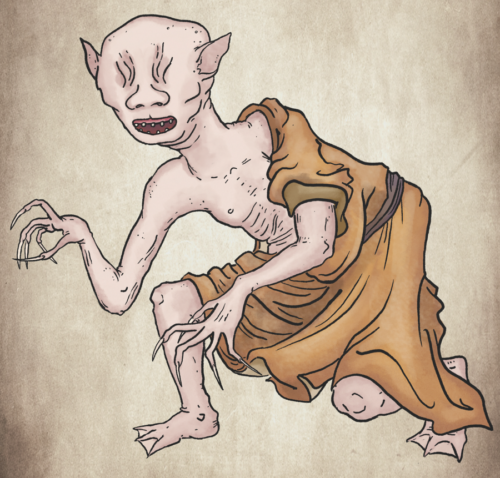Yokai were often used as a way to poke fun at certain social topics that were taboo or illegal to talk about. The Edo Period, while relatively peaceful and prosperous, was still a military dictatorship, and the shogunate had the final word on what you could print or publish. Political cartoons were certainly off limits. However, a carefully designed yokai could skirt around those limits, and its message would still be understandable by educated readers, while maintaining plausible deniability about its true meaning.
Today’s yokai could be one such example:

Nadezato
Nadezato
stroking zato (a blind guildsman)
Nadezato is another mysterious yokai from the Matsui Bunko Hyakki yagyo emaki. For the most part it looks like a zato, and it joins the ranks of other zato yokai (umi zato, ozato). While we don’t know for sure what the artist intended by this illustration, it’s possible to make some educated guesses.
A zato, as you may know, was a member of a blind persons’ guild during the Edo Period. In order to ensure blind people could earn an income, the shogunate restricted a few professions to blind people (a sort of early experiment in social welfare). Among these were biwa & shamisen playing, massage, and money lending. While it may seem praiseworthy to reserve some jobs for the blind, it also allowed for a lot of corruption and stratification within the zato guilds. Particularly, the money lending aspect also caused zato to be viewed with fear and distrust, and for many a gambler or brothel-goer, the sight of a zato coming towards you was as terrifying as a monster! It’s no wonder that zato were a popular subject of yokai caricatures.
Nadezato’s main features are its oddly shaped ears which are pointed like a cat’s, and its razor sharp claws which are pointed… like… a cat’s…
Wait, could nadezato be the first cat cosplayer??
The nade in nadezato means to pet or stroke something. Nademono (petting thing) is an old way to refer to a cat. A cat of course pretends to be your friend in order to get you to pet and stroke it, but will just as quickly claw and scratch you if it feels like it. This is where the idiom neko o kaburu (“to act like a cat;” i.e. to feign friendliness) comes from. Neko nade goe (“cat stroking voice;” to talk with a soft, coaxing voice) also sounds similar, and refers to that ingratiating voice you use when you’re trying to gain someone’s favor.
But wait, there’s more!
In Japan’s magical traditions (Shinto, Taoism, onmyodo, etc.) there is an item called a nademono. This is a small fetish or talisman that one can stroke or rub, and their sins and uncleanliness will be transferred from their own body and into the nademono. The nademono could then be burned, or washed away in a river, or otherwise purified, taking the owner’s sins away with it.
Some yokai-ologists have inferred that nadezato is a play on words between the idea of nade referring to a number of cat-related things, as well as a talisman for sin. The nadezato appears to be creeping around with his sharp claws outstretched, looking for prey. “To sharpen one’s claws” is a Japanese idiom meaning to seize an opportunity. Perhaps nadezato just acts like a helpless blind man in order to gain sympathy, when it is really waiting for the opportunity to pounce. Then it sinks its claws into its victim and transfers its own sins and uncleanliness to that person! Scary!
…but still none of it explains the webbed feet…
Want more yokai? Visit yokai.com and check out my yokai encyclopedias on amazon.com! Still want more? You can sign up for my Patreon project to support my yokai work, get original yokai postcards and prints, and even make requests for which yokai I paint next!
